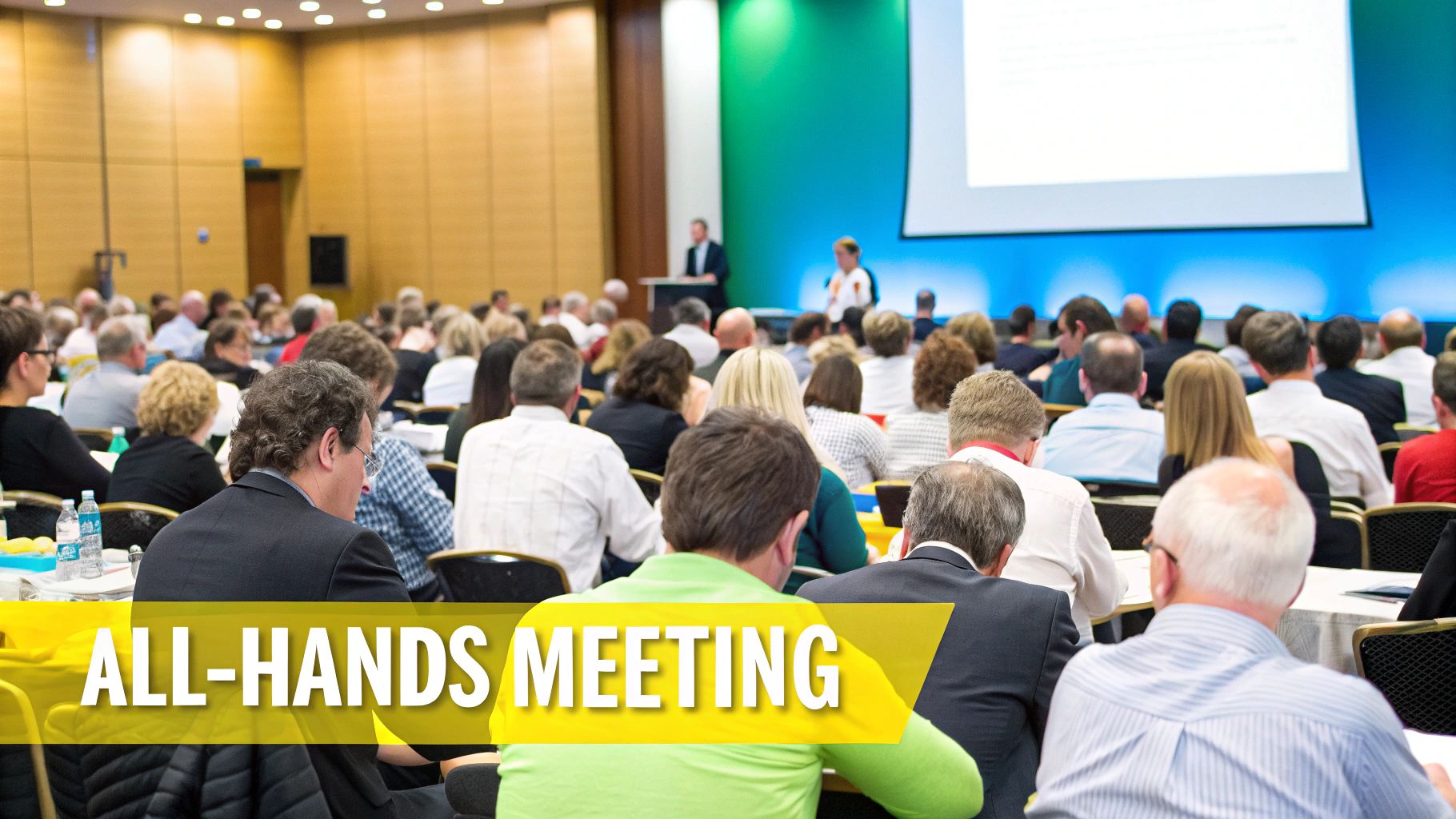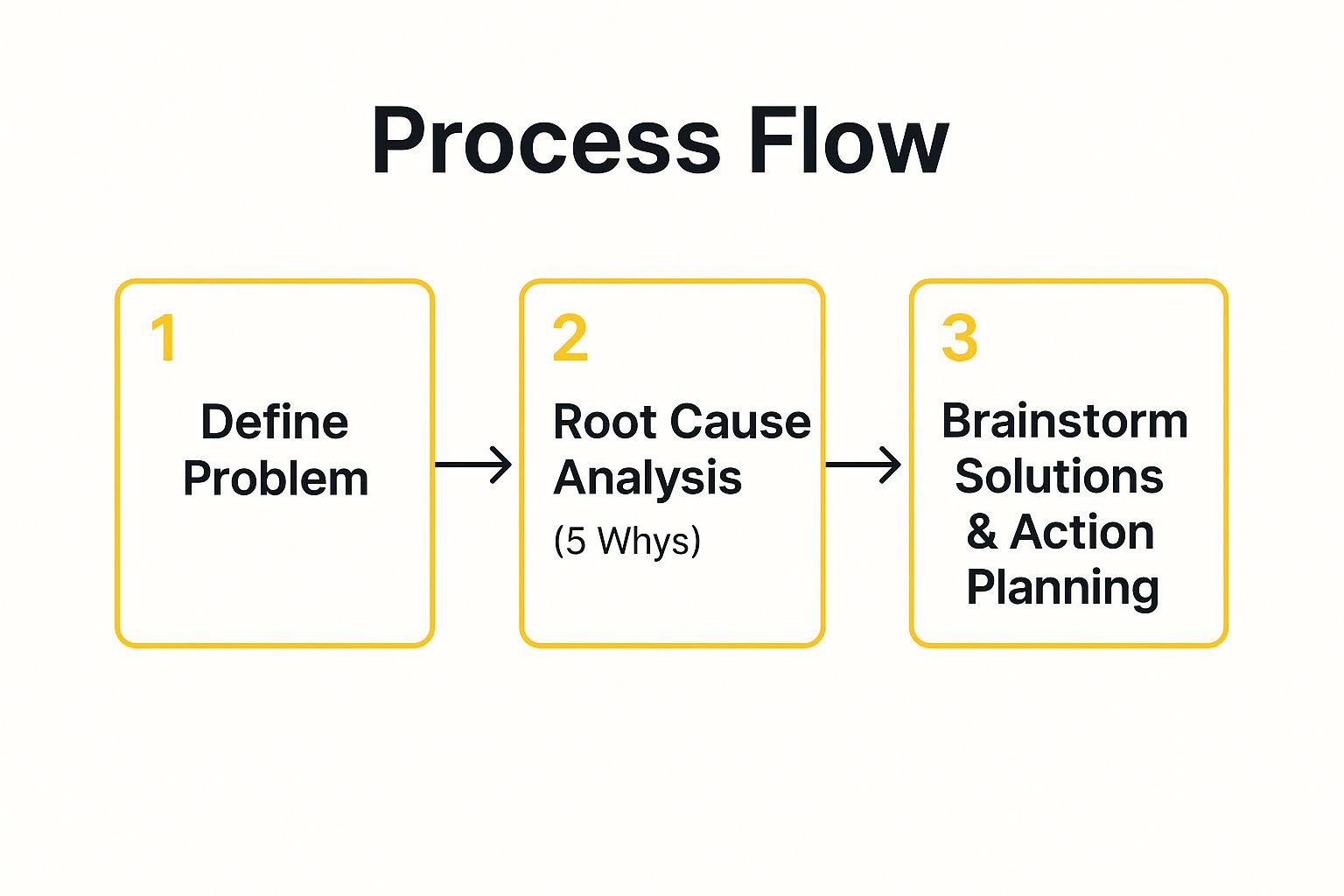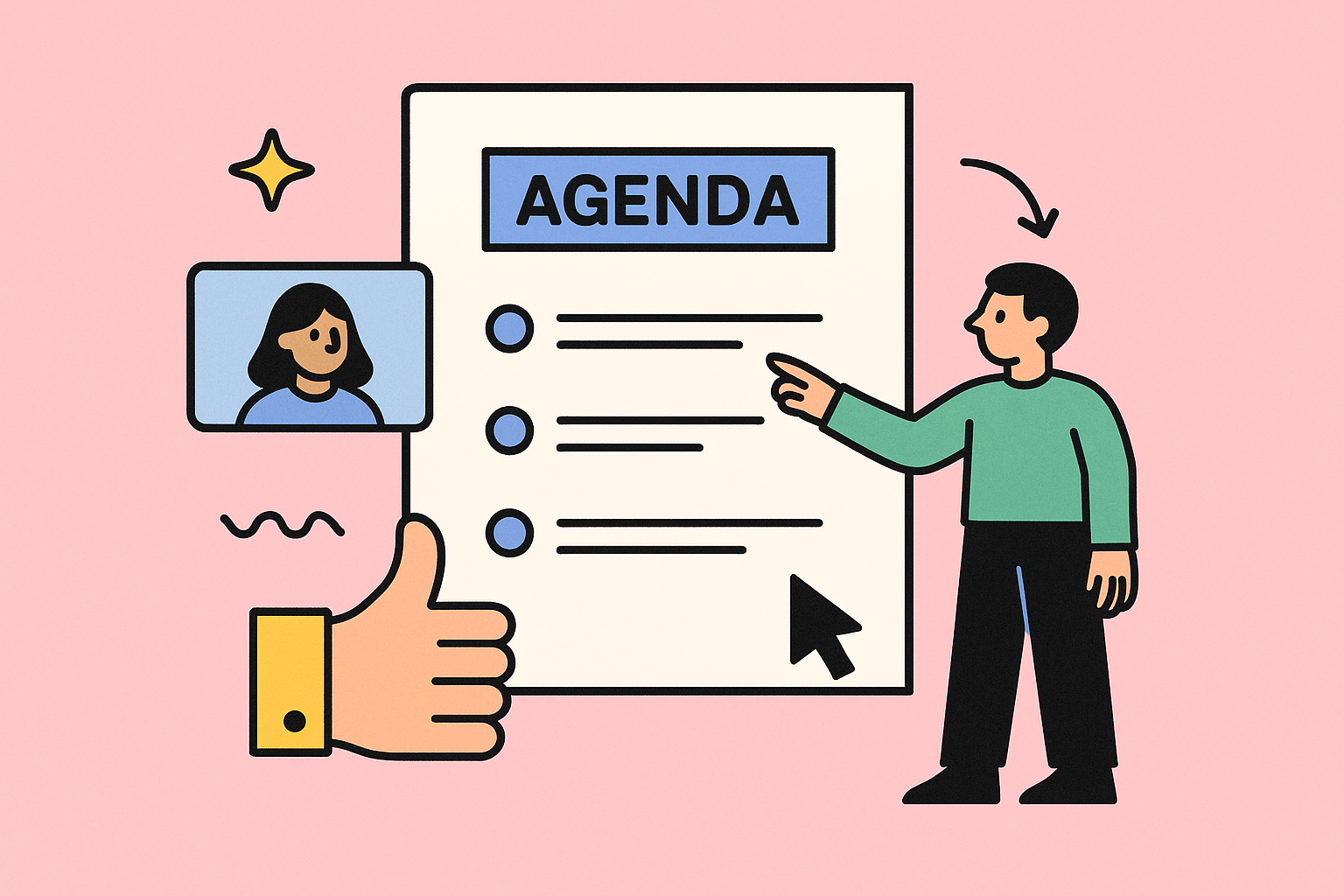Unproductive meetings are a universal drain on productivity and morale. The common thread in nearly every failed meeting is a poorly constructed or nonexistent agenda. A great agenda is far more than a simple list of topics; it’s a strategic blueprint that provides clarity, focus, and a clear path toward achieving specific outcomes. It’s the tool that transforms aimless discussions into high-impact sessions where decisions are made, obstacles are cleared, and teams achieve genuine alignment.
This guide moves beyond generic templates to provide a deep dive into seven distinct team meeting agenda examples. We will dissect the strategic purpose behind each format, from the daily stand-up to the quarterly strategic review. You’ll get actionable frameworks you can implement immediately and expert insights on adapting them to your team’s unique needs. As you plan, it’s also crucial to consider your team’s environment; adapting your blueprint is key, especially when understanding the dynamics of office vs. work from home and how that impacts collaboration. Whether you’re a Project Manager launching a new initiative or a team lead refining a retrospective, mastering these examples is your first step toward reclaiming your team’s most valuable resource: their time.
1. Weekly Stand-Up Meeting Agenda
The weekly stand-up, a cornerstone of Agile and Scrum methodologies, is a brief, highly focused meeting designed for rapid synchronization. While daily stand-ups are common, a weekly cadence works well for teams whose tasks span multiple days, reducing meeting fatigue while maintaining alignment. The core purpose is for each team member to quickly share progress, state upcoming plans for the week, and identify any impediments, ensuring the entire team has a clear view of the project’s momentum.
Pioneered by Scrum co-creators Jeff Sutherland and Ken Schwaber, this format is used by countless high-performing teams, from Spotify’s autonomous “squads” to Slack’s engineering teams. The goal is not to solve problems in the meeting but to identify them for later discussion, keeping the sync fast and efficient. This structure is one of the most effective team meeting agenda examples because it forces brevity and clarity.

Strategic Breakdown
The power of the stand-up lies in its simple, three-question structure, answered by each participant:
- What did I accomplish last week? This creates accountability and visibility into completed work.
- What will I work on this week? This aligns individual efforts with team priorities and manages dependencies.
- What is blocking my progress? This is the most critical question, as it surfaces issues immediately so they can be resolved.
Key Insight: The stand-up’s value is not in the updates themselves, but in the connections and problem-solving that happen after the meeting. It’s a diagnostic tool, not a deep-dive session.
Actionable Takeaways
To implement a successful weekly stand-up, follow these tactical guidelines:
- Time-Box Aggressively: Keep the meeting to a strict 15-30 minute limit. Use a visible timer to hold everyone accountable.
- Rotate Facilitation: Assign a different person each week to run the meeting. This promotes shared ownership and keeps the energy fresh.
- Create a “Parking Lot”: When a topic requires a longer discussion, add it to a “parking lot” list. Address these items after the stand-up with only the necessary people. This respects everyone’s time.
- Stand Up (Even Remotely): The physical act of standing encourages brevity. For remote teams, like those at Buffer, having cameras on and maintaining focus is the virtual equivalent.
2. Monthly All-Hands Meeting Agenda
The monthly all-hands meeting is a large-scale, comprehensive gathering designed to align an entire department or company on strategic direction, key results, and shared culture. Unlike daily or weekly syncs, its purpose is less about tactical execution and more about fostering transparency, celebrating collective wins, and reinforcing organizational vision. This format ensures every employee, regardless of their role, feels connected to the bigger picture and understands how their work contributes to overarching goals.
Pioneered by leaders at companies like Google with its legendary TGIF meetings and embraced by modern tech giants from HubSpot to Airbnb, the all-hands is a powerful tool for building an informed and engaged workforce. When structured effectively, it becomes a cornerstone of a strong internal communication plan. This structure is one of the most vital team meeting agenda examples for scaling culture and strategy across a growing organization.

Strategic Breakdown
The all-hands agenda is designed to cover a wide spectrum of information efficiently, moving from high-level strategy to individual recognition:
- Company Vision & Strategic Updates: The leadership team shares progress against quarterly or annual goals, market positioning, and upcoming strategic initiatives.
- Department/Team Highlights: Different departments showcase a key project or recent success story, promoting cross-functional awareness and appreciation.
- Wins & Recognition: Publicly celebrate team and individual achievements, reinforcing desired behaviors and boosting morale.
- Open Q&A with Leadership: A dedicated segment for employees to ask unfiltered questions directly to the executive team, building trust and transparency.
Key Insight: The Q&A session is the most valuable part of an all-hands. Answering tough questions openly demonstrates authentic leadership and prevents the meeting from feeling like one-way corporate propaganda.
Actionable Takeaways
To execute a compelling all-hands meeting that energizes rather than drains, focus on these tactics:
- Share the Agenda in Advance: Distribute the agenda and solicit questions beforehand using a tool like Slido or a shared document. This allows for more thoughtful inquiries and helps leaders prepare.
- Make it Interactive: Move beyond static presentations. Incorporate live polls, breakout discussions for virtual meetings, or interactive Q&A segments to keep the audience engaged.
- Strict Time Management: A typical all-hands should run 60-90 minutes. Assign a clear time limit to each agenda item and have a facilitator who keeps the meeting on track.
- Record and Summarize: Always record the session for those who cannot attend live. Follow up with an email or post that summarizes key takeaways, decisions, and action items.
3. Project Kickoff Meeting Agenda
The project kickoff meeting is the foundational event that formally launches a new initiative. Its primary purpose is to align all stakeholders, from the core team to key executives, on the project’s vision, objectives, scope, and plan of action. This meeting sets the tone for the entire project, establishing clear communication channels, defining roles and responsibilities, and building initial momentum and shared commitment.
This agenda format is a staple in formal project management methodologies, championed by organizations like the Project Management Institute (PMI). It’s used universally, from NASA’s mission planning to McKinsey’s client engagements, because it transforms abstract goals into a concrete, collaborative starting point. A well-executed kickoff is one of the most critical team meeting agenda examples, as it directly correlates with project success by preventing misalignments that can derail work later on.

Strategic Breakdown
A successful kickoff moves beyond a simple presentation to become a working session that solidifies the project framework. The agenda should guide stakeholders through a logical flow from “why” to “how.”
- Project Vision & Goals: What is the business case? What problem are we solving, and what does success look like?
- Scope & Deliverables: Clearly define what is in and, just as importantly, what is out of scope to manage expectations.
- Roles & Responsibilities: Introduce the team and clarify who is responsible for what (e.g., using a RACI chart).
- Timeline & Milestones: Present the high-level project plan, key phases, and major deadlines.
- Risks & Communication: Acknowledge potential risks upfront and establish the communication plan and meeting cadence.
Key Insight: The kickoff is not just about sharing information; it’s about securing buy-in. The goal is for every attendee to leave the room knowing exactly what is expected of them and feeling confident in the path forward.
Actionable Takeaways
To ensure your project kickoff drives alignment and enthusiasm, follow these key practices:
- Circulate a Pre-Read: Send a concise project brief or charter at least 48 hours before the meeting. This allows participants to arrive with context, ready to contribute rather than just listen.
- Define Success Explicitly: Dedicate agenda time to collaboratively define and agree upon the key success criteria (KPIs). This creates a shared definition of “done.”
- Document Everything: Assign a dedicated note-taker. Capture all decisions, action items, and open questions. Distribute these minutes within 24 hours to maintain momentum.
- End with Clear Next Steps: Conclude the meeting by reviewing assigned action items and setting the date for the first regular project check-in. This ensures the project transitions immediately from planning to execution.
4. Retrospective Meeting Agenda
The retrospective is a reflective ceremony where teams examine their recent work, processes, and collaboration to drive continuous improvement. Unlike other meetings focused on future work, its sole purpose is to look back at a completed sprint or project cycle to identify what went well, what didn’t, and what can be changed. This commitment to iterative refinement is a core tenet of the Agile Manifesto and is essential for high-performing teams.
Popularized by Agile pioneers like Esther Derby and Norm Kerth, this format is used extensively by innovative companies. Atlassian’s engineering teams use retrospectives to refine their development cycles, while Spotify’s “squads” rely on them to maintain autonomy and effectiveness. The meeting provides a structured forum for honest feedback, turning lessons learned into concrete actions. This focus on actionable improvement makes it one of the most powerful team meeting agenda examples available.
Strategic Breakdown
A successful retrospective moves beyond simple complaints and focuses on systemic improvement. The classic format guides the team through a structured reflection:
- What went well? (Start doing) This identifies successful experiments and positive behaviors that the team should continue or amplify.
- What didn’t go well? (Stop doing) This uncovers pain points, bottlenecks, and processes that are creating friction or waste.
- What can we improve? (Continue doing with modifications) This generates actionable ideas for the next work cycle, ensuring the team evolves.
Key Insight: The goal of a retrospective is not to assign blame but to improve the system. As Norm Kerth famously stated, it operates on the “Prime Directive”: “Regardless of what we discover, we understand and truly believe that everyone did the best job they could, given what they knew at the time, their skills and abilities, the resources available, and the situation at hand.”
Actionable Takeaways
To run a productive retrospective that yields real change, apply these tactics:
- Ensure Psychological Safety: The facilitator must create an environment where team members feel safe to be candid without fear of retribution. Setting ground rules and modeling vulnerability is key.
- Use Structured Formats: Avoid an unstructured “complaint session.” Use established formats like Start/Stop/Continue, Mad/Sad/Glad, or the 4 Ls (Liked, Learned, Lacked, Longed For) to guide the discussion.
- Focus on Systems, Not People: Frame problems around processes, tools, and workflows rather than individual performance. Using specific agile coaching questions can help steer the conversation constructively. You can find excellent examples to guide this in this post about agile coaching questions on resolution.de.
- Assign Action Items: Every identified improvement should become a concrete action item with a clear owner and a due date. Track these items to ensure they are implemented in the next sprint.
5. Problem-Solving Meeting Agenda
A problem-solving meeting is a highly structured session designed to tackle a specific, pre-identified challenge. Unlike a brainstorming session which is purely generative, this meeting follows a systematic path from problem definition to root cause analysis and, finally, to an actionable solution. It moves a team from simply acknowledging an issue to committing to a concrete plan to resolve it, preventing persistent obstacles from derailing projects or team morale.
This disciplined approach was heavily influenced by the Toyota Production System, which uses methods like the “5 Whys” to dig past surface-level symptoms. Similarly, Jack Welch’s famous “Work-Out” sessions at General Electric empowered employees to identify and solve operational problems directly. These focused sessions are one of the most powerful team meeting agenda examples for creating tangible outcomes and fostering a culture of continuous improvement.
This simple process flow visualizes the disciplined, three-stage approach of a successful problem-solving meeting.

The diagram highlights that a clear definition and deep analysis must precede any solution brainstorming to prevent wasted effort on the wrong issues.
Strategic Breakdown
The effectiveness of this agenda comes from its logical progression, preventing teams from jumping to solutions before the problem is fully understood.
- Define the Problem Clearly: The meeting starts by creating a precise, mutually agreed-upon problem statement. What is the issue, who is affected, and what is its impact?
- Identify the Root Cause: Instead of addressing symptoms, the team uses structured techniques (like the 5 Whys or a fishbone diagram) to find the foundational cause.
- Generate and Select Solutions: Only after understanding the root cause does the team brainstorm potential solutions. These are then evaluated based on impact, feasibility, and resources.
- Create an Action Plan: The chosen solution is broken down into concrete, assigned action items with clear deadlines and owners. Learn more about how to effectively capture meeting notes and action items.
Key Insight: The goal is not just to find a solution, but the right solution for the real problem. Skipping the root cause analysis step is the most common reason these meetings fail.
Actionable Takeaways
To execute an effective problem-solving meeting, implement these focused tactics:
- Circulate the Problem Statement in Advance: Send the defined problem statement to all attendees at least 24 hours before the meeting. This allows them to come prepared with initial thoughts.
- Use a Neutral Facilitator: The meeting leader should guide the process without biasing the discussion. Their role is to enforce the structure, manage time, and ensure all voices are heard.
- Encourage Diverse Perspectives: The best solutions often come from a cross-section of roles and experiences. Intentionally invite people from different teams or with different viewpoints on the issue.
- Document Everything Visibly: Use a whiteboard or a shared digital document to record the problem statement, root cause analysis, potential solutions, and the final action plan. This creates transparency and a shared record of the decisions made.
6. Strategic Planning Meeting Agenda
The strategic planning meeting is a high-stakes, future-focused session designed for leadership teams to set long-term direction, allocate significant resources, and make foundational decisions. Unlike tactical or operational meetings, these sessions are held quarterly or annually and address the big questions: Where is the organization going? What major initiatives will get us there? How will we measure success? This intensive format is crucial for aligning the entire company around a unified vision.
This meeting style is a hallmark of highly successful organizations, from Amazon’s “S-team” meetings, which shape the company’s long-term bets, to Microsoft’s leadership strategy sessions. The principles guiding these meetings, popularized by business strategists like Michael Porter and Jim Collins, emphasize data-driven analysis and rigorous debate to chart a course for sustainable growth. This format is one of the most vital team meeting agenda examples for ensuring an organization doesn’t just operate day-to-day but strategically moves toward its future goals.
Strategic Breakdown
The effectiveness of a strategic planning meeting hinges on moving beyond brainstorming into structured decision-making. The agenda is designed to facilitate this transition:
- Review of Vision, Mission, and Values: Re-anchors the team in the organization’s core purpose before discussing future direction.
- SWOT/TOWS Analysis (Strengths, Weaknesses, Opportunities, Threats): Provides a situational analysis framework to ground the strategy in current reality.
- Define Key Strategic Priorities: Moves from analysis to action by identifying the 3-5 most critical objectives for the next period (e.g., quarter, year).
- Resource Allocation and Roadmap: Translates priorities into a high-level plan, assigning budgets, teams, and timelines to major initiatives.
Key Insight: The goal isn’t to create a rigid, unchangeable plan. It’s to build a strategic framework with clear assumptions, enabling the team to adapt intelligently as market conditions change.
Actionable Takeaways
To execute a high-impact strategic planning session, structure is everything. Follow these critical steps:
- Prepare a Pre-Read Document: Circulate all relevant data, market analysis, and financial reports at least 48 hours in advance. The meeting is for discussion and decision-making, not for presenting information for the first time.
- Utilize a Skilled Facilitator: An impartial facilitator can guide conversations, manage conflicting viewpoints, and ensure the meeting stays on track. This role is essential for navigating complex discussions. To explore this further, you can find meeting facilitation training to develop these skills.
- Focus on Decisions, Not Discussions: Frame agenda items as questions to be answered (e.g., “Should we enter a new market?”). This forces a decision-oriented mindset.
- Assign Clear Accountability: Every strategic initiative must end with a named owner and a clear “next action.” This ensures that momentum from the meeting translates into real-world progress.
7. One-on-One Meeting Agenda
The one-on-one meeting is a dedicated, confidential conversation between a manager and a direct report. Unlike status updates, its primary purpose is to foster individual growth, provide meaningful feedback, build trust, and ensure personal goals are aligned with team objectives. This recurring meeting is the single most important tool for a manager to support their team members, focusing on career development, well-being, and removing personal blockers.
This format was famously championed by Intel’s Andy Grove and later popularized in Silicon Valley by figures like Ben Horowitz. Today, it’s a non-negotiable practice in high-performing organizations like Google and Adobe, which replaced its annual performance reviews with a more frequent “Check-In” process. These conversations make it one of the most impactful team meeting agenda examples for individual, rather than collective, alignment and engagement.
Strategic Breakdown
A successful one-on-one is driven by the employee, not the manager. The agenda should be a flexible framework that empowers the individual to discuss what is most important to them.
- Employee’s Topics: The first and largest block of time is for the employee to discuss their challenges, successes, ideas, and career aspirations. This puts them in the driver’s seat.
- Manager’s Topics: The manager uses their time to share relevant company updates, provide coaching, and offer feedback, guided by the employee’s input.
- Future Focus: The final part looks ahead, covering upcoming priorities, professional development goals, and clear action items for both parties before the next meeting.
Key Insight: The one-on-one is not a meeting for the manager to get a status update; it’s a meeting for the employee to get the support they need. The manager’s role is to listen, ask powerful questions, and coach.
Actionable Takeaways
To elevate your one-on-ones from simple check-ins to powerful growth sessions, follow these guidelines:
- Let the Employee Own the Agenda: Ask your direct report to set and share the agenda 24 hours in advance. This ensures the meeting addresses their most pressing needs.
- Focus on Growth, Not Just Tasks: Go beyond “What are you working on?” Ask open-ended questions like “What skill do you want to develop next?” or “What part of your work is most energizing?”
- Create Psychological Safety: Make it a safe space for honest feedback in both directions. Never cancel a one-on-one; rescheduling signals to the employee that they are not a priority.
- Document and Follow Up: Take shared notes and track action items. This creates accountability and shows you are committed to their development. For more expert guidance, you can explore best practices for one-on-one meetings.
Team Meeting Agenda Types Comparison
| Meeting Type | Implementation Complexity 🔄 | Resource Requirements ⚡ | Expected Outcomes 📊 | Ideal Use Cases 💡 | Key Advantages ⭐ |
|---|---|---|---|---|---|
| Weekly Stand-Up Meeting | Low – short, time-boxed, routine | Minimal – brief, no special tools | Team alignment, quick blocker ident. | Development teams, frequent coordination | Promotes transparency; quick issue ID; low time investment |
| Monthly All-Hands Meeting | Medium – company-wide, multi-present | Moderate – multiple presenters | Strategic alignment, culture building | Large organizations, cross-department updates | Ensures org-wide alignment; fosters communication & culture |
| Project Kickoff Meeting | Medium-High – detailed prep needed | Moderate – planning documents | Clear expectations, roles, timelines | New projects, cross-functional initiatives | Sets shared understanding; early issue ID; builds commitment |
| Retrospective Meeting | Medium – facilitation skill required | Low-Moderate – structured formats | Process improvement, team learning | Agile teams, completed projects, continuous improvement | Promotes continuous learning; builds cohesion; problem prevention |
| Problem-Solving Meeting | High – systematic, skilled facil. | Moderate – structured techniques | Root cause resolution, action plans | Crisis management, operational challenges | Engages expertise; prevents recurrence; develops problem skills |
| Strategic Planning Meeting | High – extensive prep & analysis | High – data, leadership involvement | Long-term direction, resource planning | Executive teams, annual/quarterly planning | Aligns leadership; informed decisions; accountability |
| One-on-One Meeting | Medium – recurring, personalized | Low – one-on-one time | Individual growth, feedback, engagement | Manager-direct report development, performance management | Builds relationships; enables early issue detection; personal growth |
From Agenda to Action: Making Your Meetings Matter
Throughout this guide, we have moved beyond generic templates to provide a strategic breakdown of seven distinct team meeting agenda examples, from the rapid-fire Weekly Stand-Up to the in-depth Strategic Planning session. The common thread weaving through each analysis is a fundamental principle: a great agenda is not just a list of topics, but a strategic tool for driving focus, engagement, and measurable outcomes. It is the architectural blueprint for productive collaboration.
Merely copying these agendas will only yield marginal improvements. The real transformation occurs when you internalize the why behind each component. Why does a Project Kickoff need a dedicated ‘Roles and Responsibilities’ section? To preemptively eliminate ambiguity and establish clear ownership from day one. Why does a Retrospective agenda separate data gathering from generating insights? To ensure that actions are based on objective evidence, not just gut feelings. This deeper understanding empowers you to become an architect of effective communication, not just a meeting administrator.
Your Path to Meeting Mastery
To translate these concepts into tangible results, here are your actionable next steps:
- Conduct a Meeting Audit: Start by assessing your team’s current meeting cadence. Identify one recurring meeting that consistently feels unfocused or drains energy. This is your first candidate for an overhaul.
- Select and Adapt a Framework: Choose the agenda example from this article that most closely aligns with your target meeting’s purpose. Don’t just adopt it wholesale; customize it. Blend elements, adjust time allocations, and rephrase agenda items to resonate with your team’s specific language and workflow.
- Communicate the ‘Why’: Before implementing the new agenda, share it with your team and explain the strategic reasoning behind the changes. Frame it as an experiment designed to make everyone’s time more valuable and impactful. This builds buy-in and turns participants into active partners in the process.
The Broader Impact of Intentional Meetings
Mastering the art of the agenda extends far beyond reclaiming a few hours in your calendar. It cultivates a culture of respect, clarity, and psychological safety. When team members know that every meeting has a clear purpose and that their contribution is essential, engagement naturally follows.
This structured approach also has a profound effect on employee well-being. Poorly managed meetings are a significant source of frustration, context-switching, and anxiety. By creating predictable, efficient, and purposeful gatherings, you directly address these pain points. This practice becomes a core component of effective workplace stress management strategies, fostering an environment where focus can flourish. Ultimately, these team meeting agenda examples are your toolkit for transforming meetings from a necessary evil into your team’s most powerful competitive advantage.
Ready to automate the administrative burden and supercharge your Jira-based meetings? Explore how resolution Reichert Network Solutions GmbH can help you seamlessly integrate these powerful agenda strategies directly into your workflow. Learn more and see how our tools can help you run consistently better meetings.
